
Anthozoa is a class of marine invertebrates which includes the sea anemones, stony corals and soft corals. Adult anthozoans are almost all attached to the seabed, while their larvae can disperse as part of the plankton. The basic unit of the adult is the polyp; this consists of a cylindrical column topped by a disc with a central mouth surrounded by tentacles. Sea anemones are mostly solitary, but the majority of corals are colonial, being formed by the budding of new polyps from an original, founding individual. Colonies are strengthened by calcium carbonate and other materials and take various massive, plate-like, bushy or leafy forms.

Pillar coral is a hard coral found in the western Atlantic Ocean and the Caribbean Sea. It is the only species in the monotypic genus Dendrogyra. It is a digitate coral -that is, it resembles fingers or a cluster of cigars, growing up from the sea floor without any secondary branching. It is large and can grow on both flat and sloping surfaces at depths down to 20 m (65 ft). It is one of the few types of hard coral in which the polyps can commonly be seen feeding during the day.
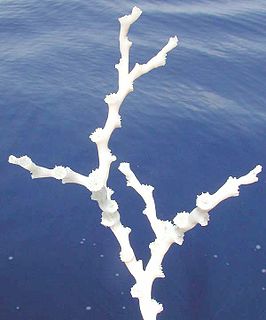
Lophelia pertusa, the only species in the genus Lophelia, is a cold-water coral which grows in the deep waters throughout the North Atlantic ocean, as well as parts of the Caribbean Sea and Alboran Sea. L. pertusa reefs are home to a diverse community, however the species is extremely slow growing and may be harmed by destructive fishing practices, or oil exploration and extraction.
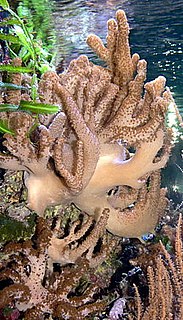
Alcyonacea, or soft corals, are an order of corals. In addition to the fleshy soft corals, the order Alcyonacea now contains all species previously known as "gorgonian corals", that produce a more or less hard skeleton, though quite different from "true" corals (Scleractinia). These can be found in suborders Holaxonia, Scleraxonia, and Stolonifera. They are sessile colonial cnidarians that are found throughout the oceans of the world, especially in the deep sea, polar waters, tropics and subtropics. Common names for subsets of this order are sea fans and sea whips; others are similar to the sea pens of related order Pennatulacea. Individual tiny polyps form colonies that are normally erect, flattened, branching, and reminiscent of a fan. Others may be whiplike, bushy, or even encrusting. A colony can be several feet high and across, but only a few inches thick. They may be brightly coloured, often purple, red, or yellow. Photosynthetic gorgonians can be successfully kept in captive aquaria.
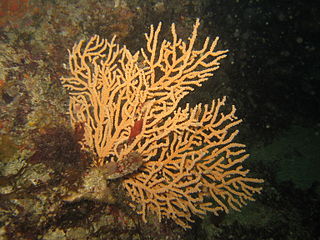
Eunicella verrucosa, the broad sea fan, pink sea fan or warty gorgonian, is a species of colonial Gorgonian "soft coral" in the family Gorgoniidae. It is native to the north-eastern Atlantic Ocean and the western Mediterranean Sea.

Porites astreoides, commonly known as mustard hill coral or yellow porites, is a colonial species of stony coral in the family Poritidae.

Leptogorgia virgulata, commonly known as the sea whip or colorful sea whip, is a species of soft coral in the family Gorgoniidae.
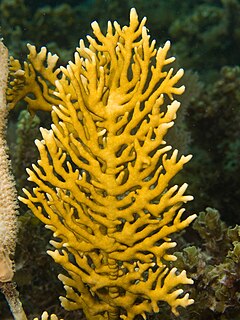
Millepora alcicornis, or sea ginger, is a species of colonial fire coral with a calcareous skeleton. It is found on shallow water coral reefs in the tropical west Atlantic Ocean. It shows a variety of different morphologies depending on its location. It feeds on plankton and derives part of its energy requirements from microalgae found within its tissues. It is an important member of the reef building community and subject to the same threats as other corals. It can cause painful stings to unwary divers.

Plexaura homomalla, commonly known as the black sea rod or Caribbean sea whip, is a species of gorgonian-type octocoral in the family Plexauridae. It is widely distributed in the Caribbean from the Florida Keys to the northern coast of Venezuela. P. homomalla contains the bioactive lipid prostaglandin A2 15-acetate methyl ester at about 3% of total wet weight.

Siderastrea radians, also known as the lesser starlet coral or the shallow-water starlet coral, is a stony coral in the family Siderastreidae. It is found in shallow parts of the western Atlantic Ocean as small, solid mounds or encrusting sheets.

Colpophyllia is a genus of stony corals in the family Mussidae. It is monotypic with a single species, Colpophyllia natans, commonly known as boulder brain coral or large-grooved brain coral. It inhabits the slopes and tops of reefs, to a maximum depth of fifty metres. It is characterised by large, domed colonies, which may be up to two metres across, and by the meandering network of ridges and valleys on its surface. The ridges are usually brown with a single groove, and the valleys may be tan, green, or white and are uniform in width, typically 2 centimetres. The polyps only extend their tentacles at night.

Plexauridae is a family of marine colonial octocorals in the phylum Cnidaria. Members of this family are found in shallow tropical and subtropical seas. Many species contain symbiotic photosynthetic protists called zooxanthellae.

Eunicea is a genus of gorgonian-type octocorals in the family Plexauridae. These branched octocorals typically have knobby protuberances from which the polyps protrude. They are often stiffened by purple sclerites and some colonies, in brightly lit back-reef areas are purple, though most colonies are brown or grey. The polyps in some species are large and feathery in appearance. The growth of these corals is rapid and they can be kept in a reef aquarium.

Paramuricea clavata, the violescent sea-whip, is a species of colonial soft coral in the family Plexauridae. It is found in shallow seas of the north-eastern Atlantic Ocean and the north-western Mediterranean Sea as well as Ionian Sea. This species was first described by the French naturalist Antoine Risso in 1826.

Antillogorgia bipinnata, the bipinnate sea plume, is a species of colonial soft coral, a sea fan in the family Gorgoniidae. It is found in the Caribbean Sea. It was first described as Pseudopterogorgia bipinnata in 1864 by the American zoologist Addison Emery Verrill. Williams and Chen (2012), transferred all the Atlantic species of Pseudopterogorgia to Antillogorgia.

Cassiopea xamachana, commonly known as the upside-down jellyfish, is a species of jellyfish in the family Cassiopeidae. It is found in warm parts of the western Atlantic Ocean, the Caribbean Sea, and the Gulf of Mexico. It was first described by the American marine biologist Henry Bryant Bigelow in 1892.

Pseudoplexaura is a genus of gorgonian-type octocorals in the family Plexauridae. They form tall, branching, tree-like colonies and are native to reefs in the Caribbean Sea and the Gulf of Mexico.
Carijoa riisei, the snowflake coral or branched pipe coral, is a species of soft coral in the family Clavulariidae. It was originally thought to have been native to the tropical western Atlantic Ocean and subsequently spread to other areas of the world such as Hawaii and the greater tropical Pacific, where it is regarded as an invasive species. The notion that it is native to the tropical western Atlantic was perpetuated from the fact that the type specimen, described by Duchassaing & Michelotti in 1860, was collected from the US Virgin Islands. It has subsequently been shown through molecular evidence that it is more likely that the species is in fact native to the Indo-Pacific and subsequently spread to the western tropical Atlantic most likely as a hull fouling species prior to its original description.
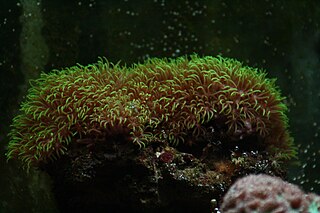
Clavularia viridis is a species of colonial soft coral in the family Clavulariidae. It is found in shallow waters in the tropical Indo-Pacific.

Savalia savaglia, commonly known as gold coral, is a species of colonial false black coral in the family Parazoanthidae. It is native to the northeastern Atlantic Ocean and the Mediterranean Sea where it often grows in association with a gorgonian. It is extremely long-lived, with a lifespan of 2,700 years, and develops into a large tree-like colony.

















